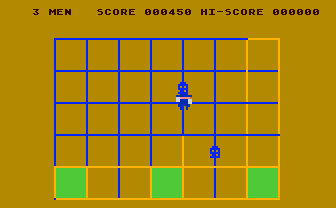Retro Replay Review
Gameplay
Cuthbert Goes Walkabout offers a deceptively simple premise that quickly evolves into a challenging puzzle-action hybrid. Players guide Cuthbert through a series of grid-based levels, tracing each cell’s perimeter to change its color. The core loop—color all cells to advance—feels immediate and satisfying, rewarding methodical planning as much as quick reflexes.
What elevates this basic formula are the “nasties” patrolling the grids. These adversaries follow predictable yet shifting patterns, demanding players to time jumps and plan routes carefully. One misstep can send Cuthbert airborne off the screen, costing a life and forcing you to start the level anew. This blend of strategy and tension keeps each stage fresh.
As you progress, levels introduce wider grids and more aggressive enemies, gradually ramping the difficulty. There’s a real sense of accomplishment when you clear a particularly dense grid without losing a life. While the controls are straightforward—move, jump, and avoid—mastery takes practice, especially when multiple nasties converge on your path.
The game also includes subtle variations, such as speed boosts and moving platforms, that spice up later stages. These additions prevent the core loop from feeling repetitive, ensuring that long-time players stay engaged. Overall, the gameplay strikes a fine balance between nostalgic simplicity and skill-based challenge.
Graphics
Although Cuthbert Goes Walkabout embraces retro aesthetics, its presentation remains crisp and colorful. The grid lines are clear and easy to read, with each cell’s color state standing out distinctly against the background. This clarity is crucial for a game where precision is everything.
Character sprites are charmingly blocky, evoking early arcade titles without feeling unfinished. Cuthbert himself is instantly recognizable—bright green overalls, bulbous head—and his jump animation conveys a satisfying arc. The nasties, while simplistic in design, feature enough variety in color and movement patterns to keep you on your toes.
Level transitions come with a subtle fade and a brief stat display showing completed cells and lives remaining. These small touches add polish without detracting from the fast-paced action. The occasional color palette shift signals a new area, breaking the visual monotony and signaling a ramp-up in difficulty.
On modern screens, the game retains its pixelated charm, avoiding blurred upscaling or jagged edges. There’s no dynamic lighting or particle effects here, but that’s part of the appeal. The straightforward visuals serve the gameplay perfectly, ensuring that every move is clear and deliberate.
Story
Cuthbert Goes Walkabout doesn’t rely on an elaborate narrative; instead, it taps into arcade traditions where gameplay takes center stage. The premise is simple: guide Cuthbert through each grid, color all cells, and outwit the roaming nasties. This minimalist storytelling keeps the focus squarely on the challenge.
Despite its lack of a deep plot, the game inherits an undercurrent of personality from the Cuthbert Saga. With each successive installment, players grow attached to the little green protagonist and his quirky world. In this chapter, his walkabout doubles as both a physical and metaphorical journey, highlighting perseverance over theatrics.
Inspirations from classics like Amidar and Oh Mummy are evident, but Cuthbert’s walkabout feels distinct thanks to its incremental difficulty curve and charming sprite work. The absence of cutscenes or dialogue may disappoint narrative-focused gamers, but those seeking pure action-puzzle enjoyment will find it refreshing.
In the end, the story here is one of pattern recognition, quick decisions, and mastering each grid layout. It’s a modest narrative approach, yet it complements the game’s arcade roots, inviting players to write their own tale of survival one colored cell at a time.
Overall Experience
Cuthbert Goes Walkabout is a delightful throwback to early arcade puzzle games, combining concise mechanics with addictive challenge. Whether you grew up in the golden age of arcades or are new to grid-based puzzlers, the game’s straightforward premise is easy to pick up yet tough to master.
The pacing is spot-on: early levels serve as gentle tutorials, while mid- to late-game stages introduce complexities that test both memory and dexterity. Lives are generous enough to encourage experimentation, but not so plentiful that mistakes feel meaningless. Each failure feels like a lesson, driving you to refine your strategy.
Multiplayer modes are absent, but the high-score chase and level progression provide ample replay value. Speedrunners will appreciate the timer, aiming for flawless clears, while casual players can savor the satisfaction of filling each grid at their own pace.
At its core, Cuthbert Goes Walkabout is a testament to the enduring appeal of arcade design: simple controls, clear objectives, and escalating difficulty. It doesn’t reinvent the wheel, but it polishes a beloved formula until it shines. For anyone craving bite-sized challenges wrapped in retro charm, this stroll with Cuthbert is well worth taking.
 Retro Replay Retro Replay gaming reviews, news, emulation, geek stuff and more!
Retro Replay Retro Replay gaming reviews, news, emulation, geek stuff and more!









Reviews
There are no reviews yet.